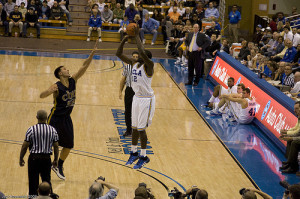What to do when your Team does not have a Shooter?

Basketball is a team sport and requires a balanced array of different roles and one commonly missing is that of a shooter. Shooters as the name implies are players within a team who can make long-range jump shots from the perimeter. They are often one of the critical elements teams go to extraordinary lengths to compensate for when they do not have them. In the sport of basketball shooters, like a true Point Guard, or an Anchoring Centre, can be one of the pieces of the puzzle often needing to be replaced with some sort of strategy to overcome this missing link.
Within a basketball offense there is a number of different roles to be played. Not having one piece of this complex array of different options is not the be all and end all of a team’s offense. All it means is that these weaknesses need to be minimised and if possible, over time strengthen as much as possible so they no longer pose as significant a threat to the teams operations.
Recoginse the Opportunities
One of the first steps in dealing with a poor shooting team from long range is to identify those within the group with the longest possible range from what you currently do have. Just because a player cannot make three-point shots, does not mean they do not have extended range from within the arch. There is still plenty of room from which to extend a defence from within the three-point line. In some cases, this will mean simple adjustment to the placing of players or where they must be aware of taking their shots from so they are within their range.
By identifying those players with an extended two point range this will also serve as an opportunity to underline those players who should be worked with most closely to achieve over the course of the season some potential for a three-point threat.
Practice, Practice, and Practice some more…
Once a team has identified those players with the best possible chance of becoming a competent shooter. These players then need to be given opportunities to practice this skill at length. This may mean additional small group sessions; work on form shooting and lots of repetitions. Ensure though that once the individual’s technique is refined that shooting under pressure is incorporated as soon as possible.
Being a good shooter is more than just being able to make a shot from the three-point line. It is about consistency under pressure. To achieve this outcome game like situations need to be employed and executed at a game pace with live defence.
Do Not Compound Problems
Try to avoid magnifying the issue of not have a shooter. Take add steps to think about the offense being implemented and how this can be refined to not be affected by not having a shooter. Nothing hurts a team worse than not having a shooter, but still placing players into these positions within a play. Players will still attempt these shots, miss and create turnovers of possession without a high percentage shooting opportunity being the outcome.
As mentioned in the first point ensuring players are aware of their shooting range is one tactical change, which can be employed, and there are a few others:
- Early offense out of fast breaks, broken play and transition do not require three-point shooting
- Full court pressure defence’s will need to be explored to help with creating opportunities to make up deficits in points
- Provide more cutting opportunities towards the basket to compensate for less opportunities from the perimeter
- Utilise screening heavily to allow players to become free. Defences when playing against a team without a shooter will sag into the three-point line. Various screening actions can help free players create offensive opportunities off and on the ball
- When screening, have screeners roll into shooting range positions where they might normally flare for further away shots
- Incorporate mid-range offensive possibilities into all offense/play breakdowns. Often coaches tend to focus on the three-point shot, or a drive to the basket instead of also discussing these in-between options
- Players when rotating need to be focusing on passing opportunities rather than catch and shoot options. Players especially when forming sideline triangles often use passing as a secondary option. However in a team without a shooter this passing option to also be explored with more importance and this will need to be done more regularly in games to keep points ticking over
Rebounding must be a way of Life
If a team does not have a shooter, then rebounding must become a very highly valued characteristic that all players must display. Ensuring consistency within a team’s offensive rebounding strategy will help reduce the effects of a below average shooting performance.
A some stage a coach will find a team that does not have a shooter. Developing a shooter can be a lengthy process if the identified possible players do not put in the work, day in and day out. So a coach should think about adapting their offense to meet the abilities of the team.

